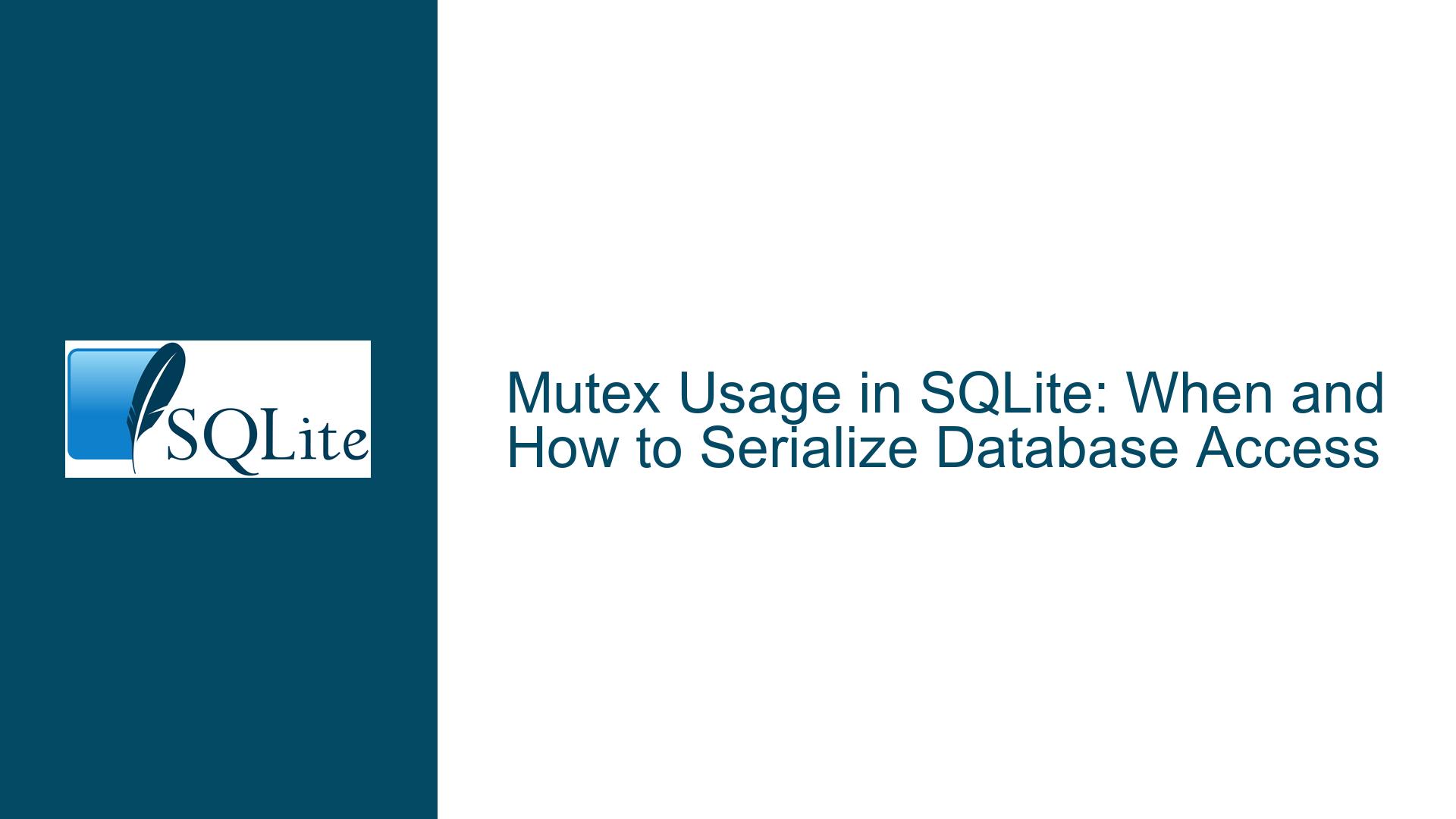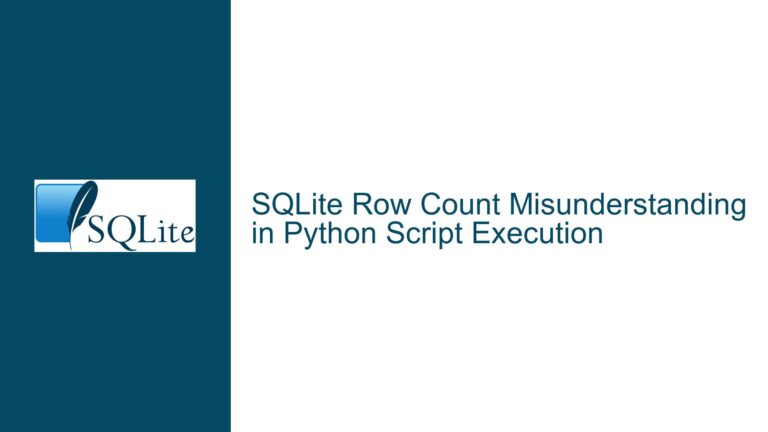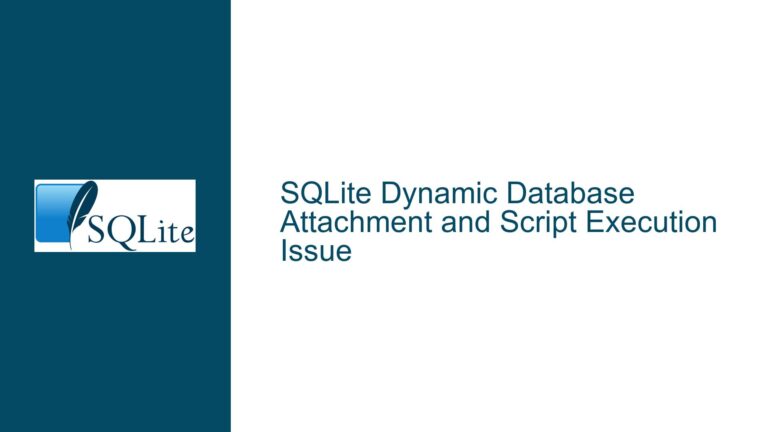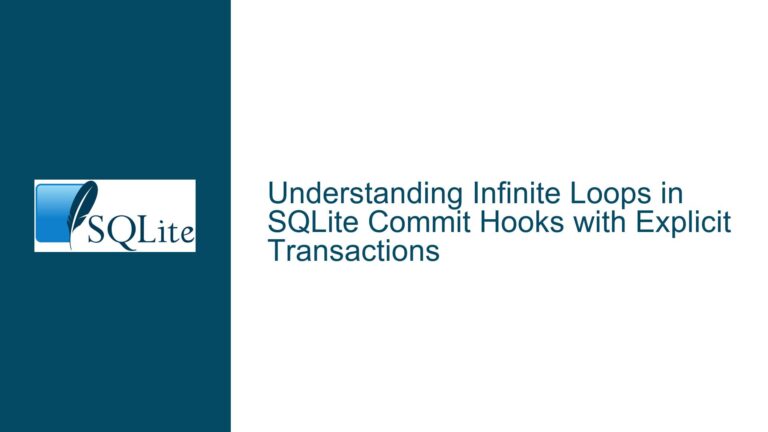Mutex Usage in SQLite: When and How to Serialize Database Access
Understanding the Need for Manual Mutex Control in SQLite
SQLite is a lightweight, serverless, and self-contained database engine that is widely used in embedded systems, mobile applications, and desktop software. One of its key features is its ability to handle concurrent access to the database file, even in multi-threaded environments. SQLite achieves this through internal mechanisms such as locks, mutexes, and journaling modes. However, there are scenarios where developers may feel the need to manually control mutexes using functions like sqlite3_mutex_enter or sqlite3_mutex_try. This typically arises from a misunderstanding of SQLite’s concurrency model or a specific use case that requires fine-grained control over database access.
The primary reason developers consider manual mutex control is to prevent race conditions during read/write operations. A race condition occurs when two or more threads access shared data concurrently, and the outcome depends on the timing of their execution. In the context of SQLite, this could mean two threads attempting to write to the same database file simultaneously, leading to data corruption or inconsistent states. While SQLite’s internal mechanisms are designed to handle such scenarios, there are edge cases where manual intervention might seem necessary.
For instance, if an application performs complex transactions involving multiple database operations, a developer might want to ensure that no other thread interferes with these operations until they are completed. This could be particularly relevant in scenarios where the application logic requires strict serialization of certain tasks, such as financial transactions or inventory management. However, it is crucial to understand that SQLite already provides robust mechanisms for handling concurrency, and manual mutex control should only be considered after a thorough evaluation of the specific requirements and potential risks.
Misconceptions and Risks of Manual Mutex Management
One of the most common misconceptions about SQLite is that it lacks sufficient built-in protection against race conditions, leading developers to believe that manual mutex control is necessary. This misconception often stems from a lack of understanding of SQLite’s concurrency model and the role of its internal mutexes. SQLite uses a combination of file locks and mutexes to manage concurrent access to the database. File locks prevent multiple processes from writing to the database simultaneously, while mutexes ensure that only one thread within a process can access critical sections of the SQLite code at a time.
When developers attempt to manually control mutexes, they risk introducing new issues such as deadlocks, livelocks, and performance bottlenecks. Deadlocks occur when two or more threads are waiting for each other to release mutexes, resulting in a standstill. Livelocks happen when threads are constantly trying to acquire mutexes but never succeed, leading to wasted CPU cycles. Performance bottlenecks can arise if the manual mutex control is overly restrictive, causing threads to wait unnecessarily and reducing the overall throughput of the application.
Another risk is the potential for incorrect implementation. SQLite’s internal mutexes are carefully designed and tested to work seamlessly with its other components. By introducing custom mutex control, developers may inadvertently disrupt this delicate balance, leading to unpredictable behavior. For example, if a developer acquires a mutex but fails to release it due to an error or oversight, the database could become unresponsive or even corrupted.
Furthermore, manual mutex control can complicate the codebase, making it harder to maintain and debug. SQLite’s built-in mechanisms are well-documented and widely understood, whereas custom mutex management requires additional documentation and expertise. This can increase the cognitive load on developers and make it more difficult to onboard new team members.
Leveraging SQLite’s Built-in Concurrency Mechanisms
Instead of resorting to manual mutex control, developers should first explore SQLite’s built-in concurrency mechanisms, which are designed to handle most common scenarios efficiently. One of the key features is the journaling mode, which determines how SQLite handles transactions and ensures data integrity. The most commonly used journaling modes are DELETE, TRUNCATE, PERSIST, and WAL (Write-Ahead Logging).
The WAL mode, in particular, is highly recommended for applications that require high concurrency and performance. In WAL mode, writes are appended to a separate log file instead of overwriting the main database file. This allows multiple readers to access the database simultaneously while a single writer is active. The WAL mode also reduces the likelihood of contention and improves overall throughput.
Another important feature is the busy_timeout setting, which specifies how long SQLite should wait for a lock to be released before returning an error. By setting an appropriate busy_timeout, developers can avoid the need for manual mutex control and allow SQLite to handle contention gracefully. The default value is 0, which means SQLite will immediately return an error if a lock is unavailable. Increasing this value can help reduce the frequency of errors in high-concurrency environments.
SQLite also provides the PRAGMA locking_mode directive, which allows developers to control the locking behavior at the database level. The two available modes are NORMAL and EXCLUSIVE. In NORMAL mode, SQLite acquires and releases locks as needed, while in EXCLUSIVE mode, it holds a lock for the entire duration of the connection. The EXCLUSIVE mode can be useful in scenarios where the application requires exclusive access to the database, but it should be used with caution as it can reduce concurrency.
In addition to these features, SQLite offers a range of other settings and directives that can be used to fine-tune its behavior. For example, the PRAGMA synchronous directive controls how aggressively SQLite flushes data to disk, which can impact both performance and data integrity. The PRAGMA foreign_keys directive enables or disables foreign key constraints, which can be useful in scenarios where the application needs to enforce referential integrity.
By leveraging these built-in mechanisms, developers can achieve the desired level of concurrency and data integrity without resorting to manual mutex control. This approach not only simplifies the codebase but also reduces the risk of introducing new issues. It is important to thoroughly understand these features and their implications before making any changes to the default settings.
In conclusion, while manual mutex control may seem like a viable solution for certain scenarios, it is generally not recommended due to the risks and complexities involved. SQLite’s built-in concurrency mechanisms are robust and well-suited for most applications. Developers should focus on understanding and utilizing these features to achieve optimal performance and reliability. If manual mutex control is deemed necessary, it should be approached with caution and thoroughly tested to ensure that it does not introduce new issues or disrupt the existing functionality.






